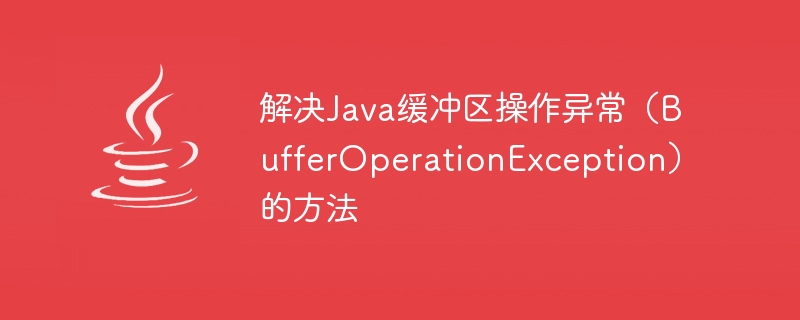

Methods to solve Java buffer operation exception (BufferOperationException)
Introduction:
When using Java's IO and NIO for file or network operations, we often A buffer operation exception will be encountered. These exceptions are usually caused by insufficient buffer size, incorrect operation, or wrong buffer status. In order to better handle these exceptions, we need to understand their causes and solutions.
1.1. Insufficient buffer capacity: When the buffer size is less than When data needs to be read or written, a buffer overflow exception occurs.
1.2. Buffer status error: Some status markers may be maintained inside the buffer, such as position, limit, capacity, etc. When the values of these status markers are incorrect, the buffer operation will be abnormal.
1.3. Incorrect operation: There may be some constraints on the operation of the buffer, such as the read position is smaller than the write position, the clearing operation must be after the writing operation, etc. When these constraints are violated, buffer operation exceptions occur.
Based on the above reasons, we can provide some solutions to handle buffer operation exceptions.
2.1. Check the buffer capacity:
Before reading and writing the buffer, we should first check whether the buffer capacity is sufficient. You can get the remaining space available in the buffer by using the remaining() method, and then compare it with the size of the data to be read and written. If there is insufficient remaining space, the buffer capacity needs to be expanded.
The sample code is as follows:
ByteBuffer buffer = ByteBuffer.allocate(1024);
int dataSize = 1024;
if (buffer.remaining() < dataSize) {
ByteBuffer newBuffer = ByteBuffer.allocate(buffer.capacity() + dataSize);
buffer.flip();
newBuffer.put(buffer);
buffer = newBuffer;
}In the above code, we first check whether the remaining space of the buffer is less than the size of the data that needs to be read and written. If so, create a new buffer, And copy the data in the original buffer to the new buffer.
2.2. Check the buffer status:
Before using the buffer, you should ensure that the buffer's status mark is correct. The current state of the buffer can be obtained using the position(), limit(), and capacity() methods. If you find that the status mark is incorrect, you can reset position to 0 by using the rewind() method, or use the clear() method to reset position and limit to appropriate values.
The sample code is as follows:
ByteBuffer buffer = ByteBuffer.allocate(1024);
//...
buffer.flip(); // 切换为读模式
//...
if (buffer.position() != 0) {
buffer.rewind(); // 复位position到0
}In the above code, after using the flip() method in read mode, we checked whether the position is 0. If not, Then use the rewind() method to reset position to 0.
2.3. Check the correctness of the operation:
Before reading and writing the buffer, you need to ensure the correctness of the operation. For example, if you want to clear a buffer, you should write first and then clear it. Also make sure the read position is smaller than the write position etc.
The sample code is as follows:
ByteBuffer buffer = ByteBuffer.allocate(1024);
//...
buffer.put("Hello".getBytes());
//...
if (buffer.position() != 0) {
buffer.clear(); // 清空缓冲区
}In the above code, after writing the data, we checked the writing position through the position() method. If it is not 0, Just use the clear() method to clear the buffer.
Summary:
When we perform Java buffer operations, we often encounter buffer operation exceptions. In order to resolve these exceptions, we can prevent exceptions in advance by checking buffer capacity, status, and operation correctness. This can effectively avoid buffer operation abnormalities and improve program stability and reliability.
I hope the solutions provided in this article can help you and enable you to better handle Java buffer operation exceptions (BufferOperationException).
The above is the detailed content of Methods to solve Java buffer operation exception (BufferOperationException). For more information, please follow other related articles on the PHP Chinese website!
